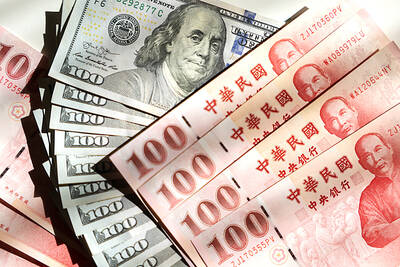European stocks were little changed, posting their best monthly advance since February, even as a slump in energy companies offset a gain in travel shares.
The STOXX Europe 600 Index slipped 0.1 percent to 347.25 at the close on Friday, paring losses of as much as 0.6 percent in the final half hour of trading.
A gauge of oil and gas companies fell 3.5 percent, capping its worst week since August 2011, as Brent and West Texas Intermediate headed for their biggest weekly drops since 2011. Air France-KLM Group rose 6.4 percent, leading an index of travel shares to its highest level in more than seven years on expectations that lower fuel costs would boost profitability.
“OPEC’s decision yesterday [Thursday] came as a surprise when looking at the market reaction, and made investors more cautious,” said Tobias Britsch, who helps oversee about US$30 billion at Meriten Investment Management GmbH, in Dusseldorf, Germany. “This could hurt a year-end rally. I would not touch oil and gas stocks as it’s far too risky now.”
Europe’s equity benchmark gained 3.1 percent this month, as European Central Bank (ECB) President Mario Draghi said the bank might broaden its asset-buying program to include the purchase of government bonds, while central banks in Japan and China stepped up measures to support their economies.
The STOXX 600 is 0.7 percent off its June peak, which was the highest level since January 2008. Germany’s DAX rose 0.1 percent on Friday, its 12th straight gain and longest winning streak since May last year. National benchmark gauges climbed in 10 of the 18 western European markets. The UK’s FTSE 100 slipped less than 0.1 percent, while France’s CAC 40 gained 0.2 percent.
Investors are also weighing the prospects for increased stimulus before the ECB meets next week to discuss monetary policy. Euro-area inflation slowed to 0.3 percent this month from a year earlier, according to EU data. The rate has been below 1 percent since September last year. The ECB has pledged more stimulus if needed to revive consumer prices.
“Lower energy prices could put some pressure on euro-area inflation and the ECB might need to go for full QE,” Britsch said, referring to quantitative easing.
A separate release showed unemployment in the region held at 11.5 percent last month.
Energy stocks extended a five-day decline to 9.4 percent after the 12-nation OPEC kept its output target unchanged on Thursday. Statoil ASA dropped 7.3 percent to its lowest price in 15 months, while Total SA slid 2 percent. BG Group PLC slipped 8.8 percent to its lowest price since March 2009.
The gauge of oil and gas firms on the STOXX 600 posted its third straight monthly drop, its longest losing streak in almost two years.
Travel and leisure stocks rose, extending a two-day advance to 3.3 percent. Deutsche Lufthansa AG gained 4.9 percent as UBS Group AG recommended buying the shares.
Aurubis AG dropped 3.2 percent after Goldman Sachs Group Inc cut its rating on Europe’s biggest producer of refined copper to neutral from buy. Ingenico Group rose 3.1 percent after Morgan Stanley upgraded its recommendation on the French maker of payment terminals.

MARKET LEADERSHIP: Investors are flocking to Nvidia, drawn by the company’s long-term fundamntals, dominant position in the AI sector, and pricing and margin power Two years after Nvidia Corp made history by becoming the first chipmaker to achieve a US$1 trillion market capitalization, an even more remarkable milestone is within its grasp: becoming the first company to reach US$4 trillion. After the emergence of China’s DeepSeek (深度求索) sent the stock plunging earlier this year and stoked concerns that outlays on artificial intelligence (AI) infrastructure were set to slow, Nvidia shares have rallied back to a record. The company’s biggest customers remain full steam ahead on spending, much of which is flowing to its computing systems. Microsoft Corp, Meta Platforms Inc, Amazon.com Inc and Alphabet Inc are

Luxury fashion powerhouse Prada SpA has acknowledged the ancient Indian roots of its new sandal design after the debut of the open-toe footwear sparked a furor among Indian artisans and politicians thousands of miles from the catwalk in Italy. Images from Prada’s fashion show in Milan last weekend showed models wearing leather sandals with a braided design that resembled handmade Kolhapuri slippers with designs dating back to the 12th century. A wave of criticism in the media and from lawmakers followed over the Italian brand’s lack of public acknowledgement of the Indian sandal design, which is named after a city in the

The US overtaking China as Taiwan’s top export destination could boost industrial development and wage growth, given the US is a high-income economy, an economist said yesterday. However, Taiwan still needs to diversify its export markets due to the unpredictability of US President Donald Trump’s administration, said Chiou Jiunn-rong (邱俊榮), an economics professor at National Central University. Taiwan’s exports soared to a record US$51.74 billion last month, driven by strong demand for artificial intelligence (AI) products and continued orders, with information and communication technology (ICT) and audio/video products leading all sectors. The US reclaimed its position as Taiwan’s top export market, accounting for

INVESTOR RESILIENCE? An analyst said that despite near-term pressures, foreign investors tend to view NT dollar strength as a positive signal for valuation multiples Morgan Stanley has flagged a potential 10 percent revenue decline for Taiwan’s tech hardware sector this year, as a sharp appreciation of the New Taiwan dollar begins to dent the earnings power of major exporters. In what appears to be the first such warning from a major foreign brokerage, the US investment bank said the currency’s strength — fueled by foreign capital inflows and expectations of US interest rate cuts — is compressing profit margins for manufacturers with heavy exposure to US dollar-denominated revenues. The local currency has surged about 10 percent against the greenback over the past quarter and yesterday breached